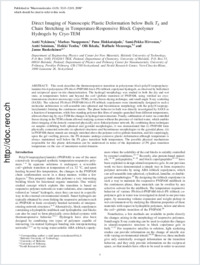Direct imaging of nanoscopic plastic deformation below bulk Tg and chain stretching in temperature-responsive block copolymer hydrogels by Cryo-TEM
- Nykänen, Antti Department of Engineering Physics and Center for New Materials, Helsinki University of Technology, Finland
- Nuopponen, Markus Department of Chemistry, University of Helsinki, Finland
- Hiekkataipale, Panu Department of Engineering Physics and Center for New Materials, Helsinki University of Technology, Finland
- Hirvonen, Sami-Pekka Department of Chemistry, University of Helsinki, Finland
- Soininen, Antti Department of Engineering Physics and Center for New Materials, Helsinki University of Technology, Finland
- Tenhu, Heikki Department of Chemistry, University of Helsinki, Finland
- Ikkala, Olli Department of Engineering Physics and Center for New Materials, Helsinki University of Technology, Finland
- Mezzenga, Raffaele Department of Physics and Fribourg Center for Nanomaterials, University of Fribourg, Switzerland - Nestlé Research Center, Lausanne, Switzerland
-
19.04.2008
Published in:
- Macromolecules. - 2008, vol. 41, no. 9, p. 3243–3249
English
This work describes the thermoresponsive transition in polystyrene-block-poly(N-isopropylacrylamide)-block-polystyrene (PS-block-PNIPAM-block-PS) triblock copolymer hydrogels, as observed by both direct and reciprocal space in-situ characterization. The hydrogel morphology was studied in both the dry and wet state, at temperatures below and beyond the coil−globule transition of PNIPAM, using vitrified ice cryo-transmission electron microscopy (cryo-TEM), in-situ freeze-drying technique, and small-angle X-ray scattering (SAXS). The selected PS-block-PNIPAM-block-PS triblock copolymers were intentionally designed in such a molecular architecture to self-assemble into spherical and bicontinuous morphology with the poly(N-isopropylacrylamide) forming the continuous matrix. The phase behavior in bulk was directly investigated by SAXS as a function of temperature, while free-standing polymer thin films of samples quenched from different temperatures, allowed observing by cryo-TEM the changes in hydrogel microstructure. Finally, sublimation of water via controlled freeze-drying in the TEM column allowed studying systems without the presence of vitrified water, which enables direct imaging of the densely connected physically cross-linked polymer network. By combining these techniques on samples exhibiting both spherical and gyroidal morphologies, it was demonstrated that (i) PNIPAM form physically connected networks in spherical structures and bicontinuous morphologies in the gyroidal phase, (ii) in PNIPAM chains strands are strongly stretched above the polymer coil-to-globule transition, and (iii) surprisingly, upon the gel swelling process, the PS domains undergo extensive plastic deformation although temperature is always maintained well below the PS glass transition bulk temperature. The possible physical mechanisms responsible for this plastic deformation can be understood in terms of the dependence of PS glass transition temperature on the size of nanometer-scaled domains.
- Faculty
- Faculté des sciences et de médecine
- Department
- Département de Physique
- Language
-
- English
- Classification
- Chemistry
- License
-
License undefined
- Identifiers
-
- RERO DOC 10757
- DOI 10.1021/ma702496j
- Persistent URL
- https://folia.unifr.ch/unifr/documents/300909
Statistics
Document views: 111
File downloads:
- pdf: 219
